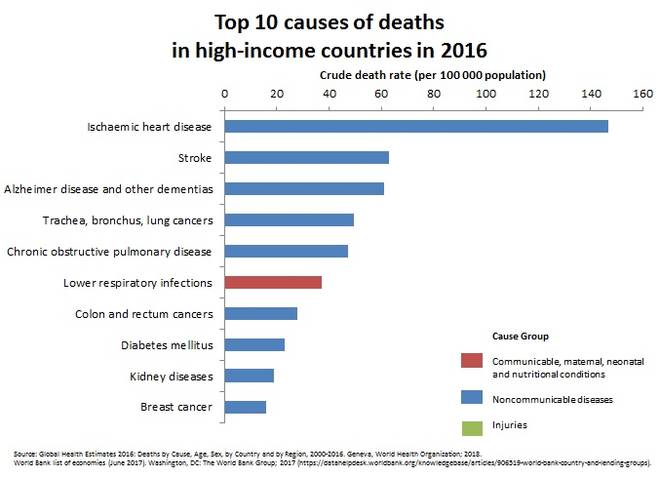
Nearly 57 million died worldwide in 2016, and more than half of them were due to the top 10 causes, according to an analysis released by the World Health Organisation.
Heart disease and stroke are the biggest killers. Between them, both diseases caused a combined 15.2m deaths in 2016. They have kept a record for being leading causes of deaths around the world in the last 15 years.
Pulmonary diseases caused 3million deaths in the period, and lung cancers claimed 1.7m lives.
Diabetes killed 1.6m people, up from less than 1m in 2000.
 |
Dementia stepped in as the 5th leading cause of death, up from 14 position in 2000. Number of deaths due to dementia doubled in the period.
Infections in the respiratory tract remained the most deadly communicable disease, claiming 3m lives.
Diarrhoeal diseases deaths decreased by almost 1m between 2000 and 2016 but still killed 1.4m that year.
Tuberculosis deaths have reduced but the disease remains among the top 10 killers, accounting for 1.3m lives.
Road injuries killed 1.4 million people. Around three in every four killed in road injuries were men and boys.
 |
Deaths by economic groups
More than half of all deaths in low-income countries in 2016 were caused by the so-called “Group I” conditions, which include communicable diseases, maternal causes, conditions arising during pregnancy and childbirth, and nutritional deficiencies.
By contrast, less than 7% of deaths in high-income countries were due to such causes.
Noncommunicable diseases (NCDs) caused 71% of deaths globally, ranging from 37% in low-income countries to 88% in high-income countries.
 |
All but one of the 10 leading causes of death in high-income countries were NCDs. In terms of absolute number of deaths, however, 78% of global NCD deaths occurred in low- and middle-income countries.
Injuries claimed 4.9 million lives in 2016.
More than a quarter (29%) of these deaths were due to road traffic injuries.
Low-income countries had the highest mortality rate due to road traffic injuries with 29.4 deaths per 100 000 population – the global rate was 18.8.
Road traffic injuries were also among the leading 10 causes of death in low, lower-middle- and upper-middle-income countries.
 |
Why do we need to know why people die?
The WHO measures each year how many people die and why they died. Along with gauging how diseases and injuries are affecting people, the measure is one of the most important means for assessing the effectiveness of a country’s health system.
Cause-of-death statistics help health authorities determine the focus of their public health actions.
A country seeing rise in deaths from heart disease and diabetes, for instance, might want to get serious about programmes to encourage lifestyle changes.
A country could also increase spending in providing effective treatment for pneumonia, when it notices many children are dying from it and the portion of the budget for treatment is inadequate.
High-income countries have systems in place for collecting information on causes of death.
Many low- and middle-income countries do not have such systems, and the numbers of deaths from specific causes have to be estimated from incomplete data.
Improvements in producing high quality cause-of-death data are crucial for improving health and reducing preventable deaths in these countries.

 Join Daily Trust WhatsApp Community For Quick Access To News and Happenings Around You.
Join Daily Trust WhatsApp Community For Quick Access To News and Happenings Around You.


